by Danna Zeiger
Danna Zeiger: It seems like just yesterday, Rebecca was interviewed here at WR for her stunning debut picture book, Brainstorm, by the fabulous Carol Gordon Ekster: https://writersrumpus.com/2022/08/09/meet-kidlit-debut-author-rebecca-gardyn-levington/
In fact, that was 1.5 years ago… and in 1.5 years, Rebecca has made amazing strides in the publishing world with an astonishing number of books that have come out or are coming out, and more yet to arrive. Rebecca is a marvel for a number of reasons. She writes solely in rhyme (and WELL, if you’ve ever heard editors gripe about rhyming manuscripts that miss the mark), she hustles and markets ingeniously; and last but certainly not least, she is extremely generous and transparent with her wisdom and advice. I’m lucky to call Rebecca my friend, and was delighted by the opportunity to sneak a peak into her newest and already starred book (by Kirkus AND School Library Journal, no less), AFIKOMEN, WHERE’D YOU GO? As usual, Rebecca provided thoughtful and super transparent answers that shine some insight into the elusive publishing industry we all so love. Join me, and enter for a giveaway at the end!
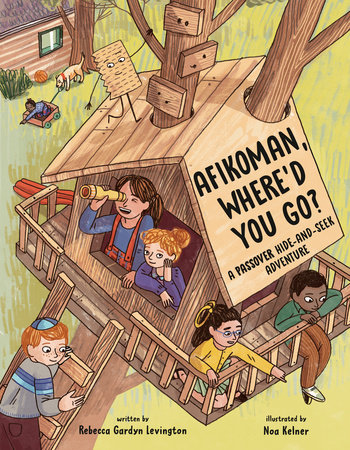
DZ: This book is such a fun and beautiful adventure! The illustrations are also so cool, creative, and imaginative –I was so impressed both by the house itself and how it was depicted. The illustrator did a beautiful job keeping us within rooms in certain scenes and also showing us the intricate house (both indoors AND outdoors) as a whole!
How many illustration notes did your original manuscript contain, if any? Did you specify much about the visual story? For example, some spreads are depicted visually in a creative way that isn’t specified in the text, and I could see the words being interpreted in multiple ways. Did you have input on options? Has your input on art varied a lot by house and editor?
RGL: I agree about Noa’s illustrations of the house! How AMAZING is that spread that shows the entire interior layout?!? I love it so much. AND it’s probably the most difficult spread for readers to find Afikoman hiding, so I love it for that reason as well!
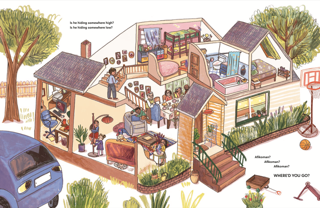
I did have a handful of illustration notes in my original manuscript, but all of them were there only to explain what was going on in the story, and I only added them when the action wasn’t fully obvious within the text. For instance, on the page where the kids finally spot the Afikoman, I had an illustration note that read:
[MC spots Afikoman, but Afikoman doesn’t realize he’s been spotted. MC winks at reader to pretend s/he’s giving up]
None of my illustration notes were about preferences in regards to how I wanted the house to look or anything like that. That was all Noa! And I was floored by what she brought to the table…(and the sofa, bathtub, etc. lol!)
In regards to how much input I had into the illustrations for this book and others, I have been very lucky in that all the editors I’ve worked with so far have always been welcoming to my feedback on the art, and many times have thanked me for coming up with solutions or interesting ideas they hadn’t thought of.
DZ: How much input did you have on the characters, the rooms, the color palette, and the illustrations in general? For example, did you hope to match a house or family from your own experiences? Or, since there are many denominations of Judaism that sometimes can be depicted visually quite differently, did you have an idea about the family’s observance that you hoped to show? It seems like more than one was beautifully portrayed here–was that perhaps your vision?
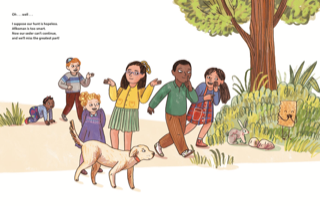
Also, did you envision the afikoman as its own character? I absolutely love him!!
RGL: Sorry to disappoint, but I had absolutely no input on the kid characters, rooms, or color palette! The house design and all the amazing details within came 100% from Noa’s brilliant imagination. (I suppose she may have based the house design on her own home; you’d have to ask her!)
One of my favorite spreads is the bathroom scene because I originally had such a scene in the text, but I took it out because my critique partners thought it was too gross to have food in the bathroom. I was SO surprised and delighted when I saw that Noa (totally on her own!) put a bathroom scene in without any illustration note or anything in the text referring to it!
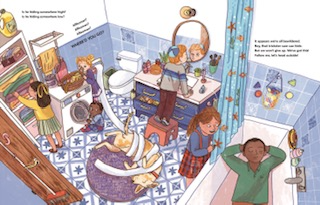
In terms of the diversity of characters and the ways this family chose to celebrate the holiday, I also can’t take credit. I think it was my editor, Lauri Hornik’s, idea to add the extra seat for Elijah at the seder table and also the oranges in the bowl, which I believe are meant as symbols of inclusion for Jews from LGTBQ and other marginalized communities. I hadn’t heard of either of these traditions before, but think it’s great that they are included in the book!
The only thing I will take some credit for is creating Afikoman as a character. He was definitely very clear in my head from the get to. My over-arching illustration note at the very top was:
[Afikoman is an anthropomorphized broken piece of matzah, running/hiding from the MC, reader, and other kids at the seder. The Afikoman is camouflaged somewhere on each spread, inviting the reader to join in the search.]
That said, when I initially wrote the manuscript, I thought of Afikoman as a smarmy, snarky, dislikeable character. In fact, I originally included a back matter “celebrity interview” where all of the Afikoman’s answers were arrogant and condescending (I still think that interview is hilarious and I may use it as fodder for a future story…who knows?!)
So I was very surprised at how Noa drew Afikoman more as a silly trickster, which – of course — makes so much more sense. In fact, after seeing the illustrations, I changed the first line of the book from: “Have you seen the Afikoman? He’s a smug and sneaky guy” to “Have you seen the Afikoman? He’s a silly, sneaky guy.”
DZ: You don’t shy away from using some more sophisticated words, which I feel are easily understood within context. I admire that–it’s so important for kids to be exposed to more complex language, too! However, I’ve heard that some editors sometimes push back on using such language in picture books – do you have any (if any) memorable “word choice” discussions you could share with our readers?
RGL: Honestly, I can’t say that I do. Thankfully, Lauri and all the editors I’ve worked with on all my books have embraced my word choices! But I agree with you that it is so important that kids are exposed to more complex language.
However, there were two “word choice”-related things that I can share. The first is that my editor initially didn’t think we needed to add a glossary to this book because she thought that most Jews would already know all the Passover terms and Hebrew words used. The second, is that the original marketing copy read: “…for Jewish fans of Where’s Waldo and The Gingerbread Man.” I pushed back on both counts. My hope was (is!) that this book will find its way into the hands of kids from all different backgrounds – Jewish AND non-Jewish — and they will all have an opportunity to enjoy reading about and participating in this fun tradition.
I felt it was very important to include the glossary so that those who aren’t as familiar with the customs would have a resource. And I asked to have it put in the front of the book so that as readers came across unfamiliar Hebrew words, they would know how to pronounce them.
As creators, our goal is to help kids understand and have empathy for one another – and the best way to do that is to expose them to stories that highlight each other’s worlds.
DZ: What is your writing process? Has it changed now that you have a number of gorgeous books under your belt? Does the process of critiquing or number of critique groups/rounds you will run your manuscript through change?
RGL: My writing process is still as torturous as it always was! Lol. I still get so frustrated with myself when the words or ideas won’t flow. I constantly feel like an imposter. That said, I have gotten better at reminding myself that feeling is part of my process, and I know that at some point it will pass. This year, I created a mantra for myself that I have up on my wall which reads:
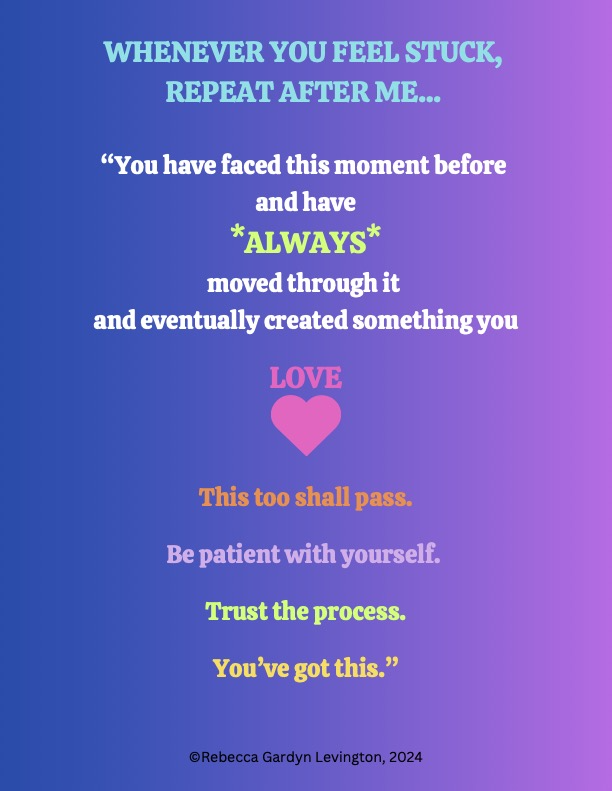
Typically, the way I get myself unstuck is to tell myself I’m “just writing a poem.” It feels a lot less daunting to write a poem than to write “A DRAFT.” Sometimes I’ll re-read old poems I’ve already written and find sparks or bigger themes I think can be expanded upon. This process hasn’t changed for me at all.
And no, the number of critiques or rounds of revision hasn’t changed. I still run it through all my critique partners as many times as I feel is needed before I’m ready to send it to my agent. The number of rounds just depends on the story and whether or not I think it needs more work.
DZ: Has the world of publishing changed now that you have multiple books underway? For example, do editors respond faster, or do you feel like editors respond differently, or is it simply easier because you can reach out to editors with existing relationships?
RGL: I don’t think any of it is “easier” at all. I still get a BOATLOAD of passes on my submissions, both from editors I’ve worked with before and from those I haven’t. I’ve now worked with 7 editors at 9 publishers and (you can probably do the math!) only two so far have acquired a second book from me. That said, I do think that editors with whom I already have a relationship tend to respond back slightly faster with their passes. But they’re still most always passes!
DZ: Where did this book start, and how do you decide upon each rhyming book’s meter/cadence, etc.? Do you come up with a catchy line or rhyme, and build the story from there? Do you come up with the idea and the arc, and then work on writing rhyming lines?
RGL: I just went back to my very first draft of this story (originally titled “Afikoman Hunt,” dated Jan. 2, 2020). I didn’t remember this, but it looks like I was first thinking of it as a young Passover board book. I see that I made a huge list of prepositions – above, below, under, over, around, atop, etc. so maybe I was thinking that could be a hook? But I do see in that even in that original draft, I’d already started playing around with the refrain, which is almost identical to the final version. It looks like once I had that refrain, the rhythm followed from there.
I don’t ever consciously choose to write in any particular meter. At this point, I’ve been writing in rhyme so long that I don’t even know what meter I’m working in (although, of course, I could figure it out if you asked me to). It is just second nature to me, so I really just let whatever rhythm I’m feeling guide me, and I just go for it!
Some people advise rhymers to write out the story in prose first to make sure it has a solid narrative or arc, and I think that is *great advice. But I never do that! (Do as I say, not as I do! Lol). Plot is definitely not my strong suit. I’ve been leaning much harder into concept and poetic picture books these days. And while those books do still of course need some kind of arc, they aren’t as strict in terms of character development and narrative structure. Typically, I just go with my rhyming flow and feelings and just try to say what I want to say within the confines of the meter. And then once I have a draft, I mold and chisel until I have a book. It is absolutely ridiculously inefficient, and it usually means I end up killing MANY perfectly rhymed darlings, but that’s just the way I work!
DZ: I love your fun ideas, and your Brainstorm hat will forever be ingrained as #author goals for me. Any fun plans for promoting this beautiful book?
RGL: Oh girl, do I! lol. See photo!
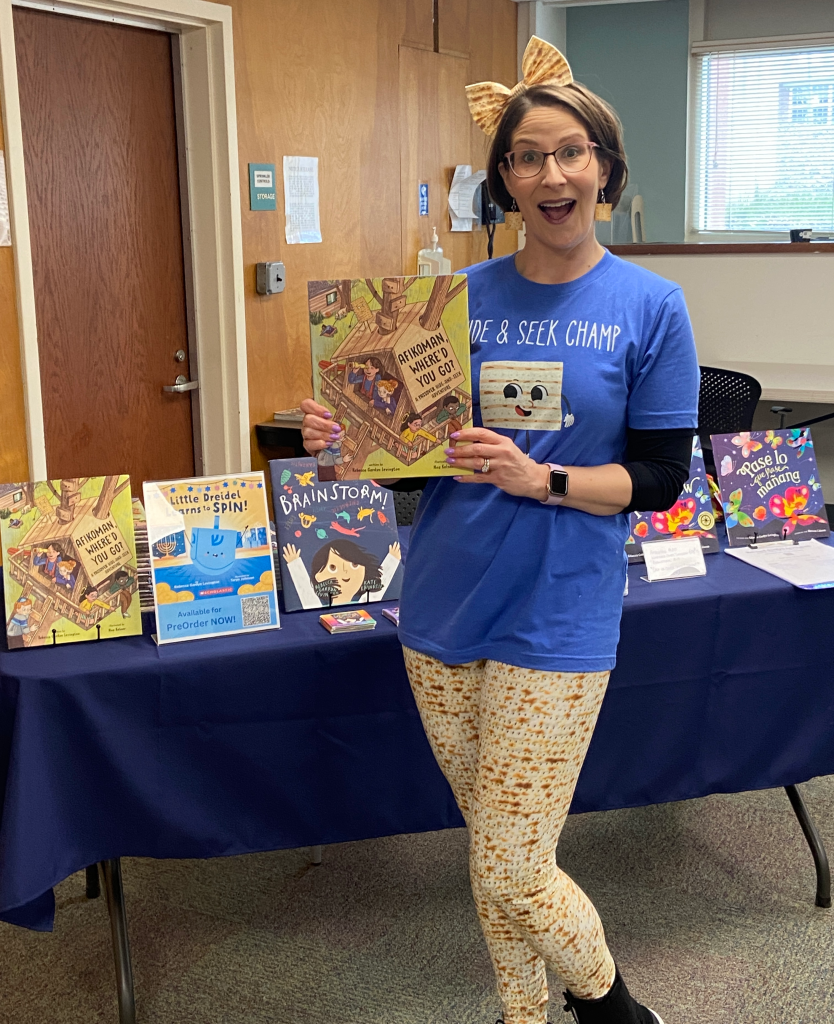
DZ: What’s next for you? Both in books coming out in the near future and long-term?
RGL: After AFIKOMAN, WHERE’D YOU GO?, I am excited to say I have another six more rhyming picture books being released within the next couple of years. Next up, on Sept. 4th, is LITTLE DREIDEL LEARNS TO SPIN, illustrated by Taryn Johnson and published by Scholastic, which is a Hanukkah picture book about Little Dreidel, who discovers that she needs persistence, patience (and a whole lot of momentum!) if she ever hopes to spin as well as her older cousins. Then, in January 2025, WRITE HERE, WRITE NOW!, illustrated by Andrea Boatta, comes out from Capstone, which presents a plethora of ways for kids to play with words while discovering the type of writing that’s “right” for them. And after that, in the spring of 2025, I WILL ALWAYS BE…, illustrated by Rahele Jomepour Bell, published by HarperCollins, is an inspirational picture book that encourages kids to celebrate their passions – whether or not they ever make it to Broadway or the big leagues – because doing what you love and loving what you do is what really matters.
*GIVEAWAY*
Rebecca is generously offering a 30 minute Ask Me Anything Giveaway!
TO ENTER: please comment on this blog post. If you share on Twitter, Bluesky, or Facebook, you get another entry–just add to your comment to share both your handle (e.g. @SOMEAUTHOR) and where you’ve shared it.
We will select winners at random. Giveaway closes in one week.
More about Rebecca:
I would love for your readers to come to my website to learn more about me and all my upcoming books and to sign up for my monthly newsletter where I offer all kinds of tips for upcoming writers: www.RebeccaGardynLevington.com.
Danna Zeiger: I’m interjecting Rebecca’s answer to let you all know that Rebecca’s newsletter is LOADED with awesome advice and insight. It’s just as transparent as her answers here. Highly recommend! 🙂
Rebecca Gardyn Levington is a children’s book author, poet, and journalist with a particular penchant for penning both playful and poignant picture books and poems – primarily in rhyme. She is the author of BRAINSTORM!, WHATEVER COMES TOMORROW and AFIKOMAN, WHERE’D YOU GO? A PASSOVER HIDE-AND-SEEK ADVENTURE, and has six additional rhyming picture books forthcoming, including LITTLE DREIDEL LEARNS TO SPIN (Scholastic, 2024), WRITE HERE. WRITE NOW! (Capstone, 2025), I WILL ALWAYS BE… (HarperCollins, 2025), and FINDING FORGIVENESS: A ROSH HASHANAH STORY (Macmillan/FSG, 2025). Rebecca writes reviews and conducts interviews monthly for the Picture Book Builders blog. Her award-winning poems and articles have appeared in numerous anthologies, newspapers, and magazines. She lives in Summit, New Jersey with her family. Find out more and sign up for Rebecca’s monthly newsletter at www.RebeccaGardynLevington.com.
Ways you can help support Rebecca and her newest release:
Review The Book! https://www.amazon.com/Afikoman-Whered-You-Hide-Seek-ebook/dp/B0C56RTDDG
Rebecca is happy to provide a watermarked PDF version of the book to anyone who would like to provide a review. Email her at RebeccaWrites4Kids@gmail.com
Add The Book To Your Good Reads “To Read” Pile! http://tinyurl.com/yex7mk3h
Ask Your Local Library to Order The Book!
May libraries have online forms to make this easy for patrons. You can also just walk into your local branch and ask! Here’s the ISBN#: 978-0593617786
Tell A Friend About The Book!
It doesn’t cost a thing to spread the word! Feel free to send folks to Rebecca’s website for more info:https://rebeccagardynlevington.com/books/whered-you-go/
Post About The Book On Social Media!
If you do, please tag Rebecca:
- Twitter/X: @WriterRebeccaGL
- Instagram: @RebeccaGardynLevington
- BlueSky: @rebeccaglevington.bsky.social
Buy the book!
[words] in Maplewood, NJ (Rebecca’s local indie): https://tinyurl.com/73xuc3j6
Bookshop.org: http://tinyurl.com/5dw9wa56
Amazon: http://tinyurl.com/24cf77rr
Or B&N.com: http://tinyurl.com/2punyxv7
(And by the way, Rebecca is happy to send personalized signed bookplates to anyone who asks! Just email her at RebeccaWrites4Kids@Gmail.com!)


Thank you for sharing your process Rebecca! Your rhyme is always a joy (or I should say, once you’ve gone through the misery of writing it, it’s a joy to read!) Congrats!
LikeLike
Great interview! I’ve enjoyed each of Rebecca’s books in turn and this sounds like another fun one. And, I agree with you Danna, her website is fantastic. I always learn something from it.
LikeLike
I love the part about your book NOT being “Waldo vs Gingerbread” – it is so much more! Thanks for sharing.
LikeLiked by 2 people
I loved “Afikoman, Where’d You Go?” and I can’t wait to read Rebecca’s other books. This review asked so many insightful questions about the process of working with illustrators and editors. I will definitely be sharing it on both my Storybook Lady Facebook page and @story.book.lady Instagram.
LikeLiked by 1 person
Thank you so, so much!! ❤
LikeLike